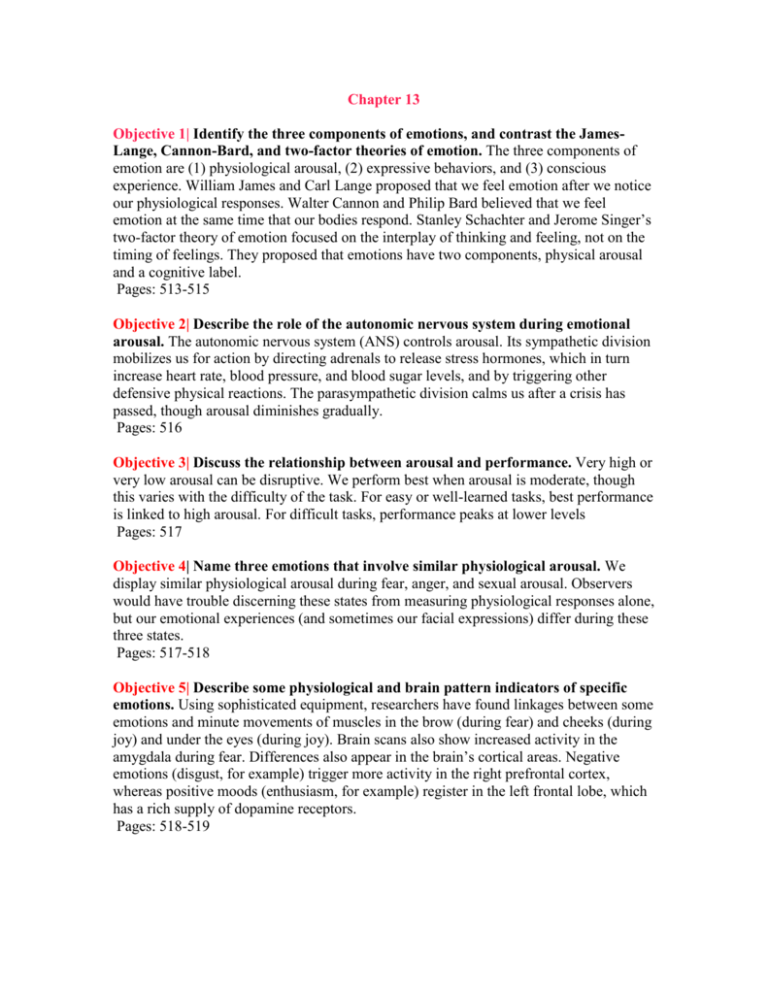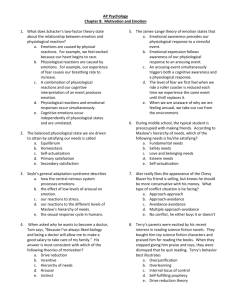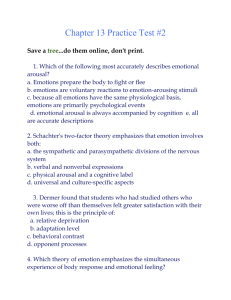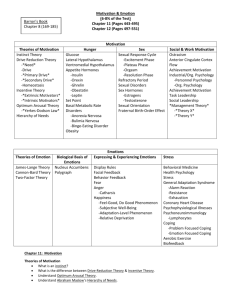File - Thrive in AP Psychology
advertisement

Chapter 13 Objective 1| Identify the three components of emotions, and contrast the JamesLange, Cannon-Bard, and two-factor theories of emotion. The three components of emotion are (1) physiological arousal, (2) expressive behaviors, and (3) conscious experience. William James and Carl Lange proposed that we feel emotion after we notice our physiological responses. Walter Cannon and Philip Bard believed that we feel emotion at the same time that our bodies respond. Stanley Schachter and Jerome Singer’s two-factor theory of emotion focused on the interplay of thinking and feeling, not on the timing of feelings. They proposed that emotions have two components, physical arousal and a cognitive label. Pages: 513-515 Objective 2| Describe the role of the autonomic nervous system during emotional arousal. The autonomic nervous system (ANS) controls arousal. Its sympathetic division mobilizes us for action by directing adrenals to release stress hormones, which in turn increase heart rate, blood pressure, and blood sugar levels, and by triggering other defensive physical reactions. The parasympathetic division calms us after a crisis has passed, though arousal diminishes gradually. Pages: 516 Objective 3| Discuss the relationship between arousal and performance. Very high or very low arousal can be disruptive. We perform best when arousal is moderate, though this varies with the difficulty of the task. For easy or well-learned tasks, best performance is linked to high arousal. For difficult tasks, performance peaks at lower levels Pages: 517 Objective 4| Name three emotions that involve similar physiological arousal. We display similar physiological arousal during fear, anger, and sexual arousal. Observers would have trouble discerning these states from measuring physiological responses alone, but our emotional experiences (and sometimes our facial expressions) differ during these three states. Pages: 517-518 Objective 5| Describe some physiological and brain pattern indicators of specific emotions. Using sophisticated equipment, researchers have found linkages between some emotions and minute movements of muscles in the brow (during fear) and cheeks (during joy) and under the eyes (during joy). Brain scans also show increased activity in the amygdala during fear. Differences also appear in the brain’s cortical areas. Negative emotions (disgust, for example) trigger more activity in the right prefrontal cortex, whereas positive moods (enthusiasm, for example) register in the left frontal lobe, which has a rich supply of dopamine receptors. Pages: 518-519 Objective 6| Explain how the spillover effect influences our experience of emotions. The spillover effect occurs when our arousal from one event influences our response to other events. Although not completely undifferentiated, emotional arousal is sometimes general enough to require us to define the emotion we are experiencing. Arousal fuels emotion; cognition channels it. Pages: 519-520 Objective 7| Distinguish the two alternative pathways that sensory stimuli may travel when triggering an emotional response. Emotional responses are immediate when sensory input goes directly to the amygdala via the thalamus, bypassing the cortex, triggering a rapid reaction that is often outside our conscious awareness. Responses to complex emotions (such as guilt, happiness, and love), require interpretation and are routed along the slower route to the cortex for analysis. Pages: 521-523 Objective 8| Describe some of the factors that affect our ability to decipher nonverbal cues. Most people can detect nonverbal cues, and we are especially sensitive to nonverbal threats. Experience contributes to our sensitivity to cues, as studies of abused children show. Pages: 524-525 Objective 9| Describe some gender differences in perceiving and communicating emotions. Women generally are better than men at reading people’s emotional cues, including those displayed during deception. Women also give more detailed descriptions of their emotional reactions; more readily describe themselves as emotional, and express empathy more often, in words and in their facial expressions. Women surpass men in conveying happiness, but men communicate anger better. Pages: 525-526 Objective 10| Discuss the research on reading and misreading facial and behavioral indicators of emotion. Facial muscles reveal signs of emotion. But lie detection methods based on facial expressions don’t yet exist, and most of us have difficulty detecting expressions of deceit. The absence of verbal or emotional cues in e-mails deprives us of an important source of information. Pages: 526-528 Objective 11| Discuss the culture-specific and culturally universal aspects of emotional expression, and explain how emotional expressions could enhance survival. The meaning of gestures varies with culture, but many facial expressions, such as those of happiness and fear, are found allover the world (and among children blind from birth), indicating that these expressions are culturally universal aspects of emotion. Cultures differ, however, in the amount of emotional expression they consider acceptable. In prelinguistic, prehistoric times, emotional expressions could have enhanced survival by enabling communication of threats, greetings, and submission. Some emotional expressions help us to take in more sensory information or to avoid taking in toxic substances. Pages: 528-529 Objective 12| Discuss the facial feedback and behavior feedback phenomena, and give an example of each. The facial feedback hypothesis proposes that expressions amplify our emotions by activating muscles associated with specific states, and the muscles signal the body to respond as though we were experiencing those states. Thus, when we simulate the facial expressions normally associated with happiness, we may feel happier. Similarly, the behavior feedback hypothesis assumes that if we move our body as we would when experiencing some emotion (shuffling along with downcast eyes, as when sad), we are likely to feel that emotion to some degree. Pages: 530-531 Objective 13| Name several basic emotions, and describe two dimensions psychologists use to differentiate emotions. Carroll Izard’s research found the 10 basic emotions of joy, interest-excitement, surprise, sadness, anger, disgust, contempt, fear, shame, and guilt. Some psychologists believe that pride and love may also be basic emotions. Emotions can be placed along two basic dimensions: arousal (high versus low) and valence (pleasant, or positive, versus unpleasant, or negative). Pages: 532-533 Objective 14| State two ways we learn our fears. What we learn through experience best explains the variety of human fears. We learn specific fears through conditioning (associating emotions with specific situations) and through observational learning (watching others display fear in response to certain events or surroundings). Pages: 533-534 Objective 15| Discuss some of the biological components of fear. We are biologically prepared to learn some fears (snakes, spiders, heights) but not others (fast driving, bombs, electricity).The amygdala plays a key role in fear learning, associating fear with specific situations. The amygdala receives information from cortical areas that process emotion, and it sends information to other areas that produce the bodily symptoms of fear. People differ in the extent to which they are fearful or fearless, and part of that difference is genetic. Pages: 534-535 Objective 16| Identify some common triggers and consequences of anger, and assess the catharsis hypothesis. Frustrating or insulting actions we interpret as willful, unjustified, and avoidable may evoke anger. Research does not support the catharsis hypothesis—the idea that releasing negative energy will calm aggressive tendencies. Venting rage may calm us temporarily, but in the long run it does not reduce anger and may actually amplify it. Anger is better handled by waiting until the level of physical arousal diminishes, calming oneself, and expressing grievances in ways that promote reconciliation rather than retaliation. When reconciliation fails, forgiveness can reduce one’s anger and its physical symptoms. Pages: 535-537 Objective 17| Describe how the feel-good, do-good phenomenon works, and discuss the importance of research on subjective well-being. The feel-good, do-good phenomenon is our increased willingness to help others when we are in a good mood. Research in positive psychology is currently exploring the causes and consequences of subjective well-being (self-perceived happiness or satisfaction with life), supplementing psychology’s traditional focus on negative emotions. Pages: 537-538 Objective 18| Discuss some of the daily and longer-term variations in the duration of emotions. Negative emotion is highest just after we wake up and before we go to sleep. Positive emotion rises gradually, peaking about seven hours after we rise, then falls gradually. The moods triggered by the day’s good or bad events seldom last beyond that day. Even significant bad events, such as a serious illness, seldom destroy happiness for long, although we tend to underestimate our capacity to adapt. Pages: 538-539 Objective 19| Summarize the findings on the relationship between affluence and happiness. At a basic level, money helps us avoid pain by enabling better nutrition, health care, education, and science, and these in turn increase happiness. Increases in wealth can also increase happiness in the short term. But in the longer term, research does not show an increase in happiness accompanying affluence at either the individual or national level. Pages: 539-542 Objective 20| Describe how adaptation and relative deprivation affect our appraisals of our achievements. The adaptation-level phenomenon is our tendency to assess stimuli (including material possessions) by contrasting them with a neutral level that changes with our experience. The relative-deprivation principle is our perception that we are less well off than others with whom we compare ourselves. Thus, happiness is relative to both our past experience and our comparisons with others. Pages: 542-543 Objective 21| Summarize the ways that we can influence our own levels of happiness. Happiness is in part genetically inherited, and in part under our own control. Research-based suggestions for improving our own happiness are (1) realizing that enduring happiness doesn’t come from financial success; (2) taking control of one’s time; (3) acting happy; (4) seeking work and leisure that engages one’s skills; (5) exercising regularly; (6) getting adequate sleep; (7) giving priority to close relationships; (8)focusing beyond oneself; (9) being grateful for what we have; and (10) nurturing our spiritual selves. Pages: 543-545








